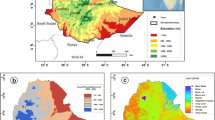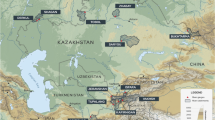Abstract
Glacier retreat and thinning are occurring in many regions of the world, leading to significant changes in river discharge, water quality and aquatic ecosystems. Therefore, it is increasingly necessary for environmental scientists and managers to develop and adopt methods that link changes in meltwater dynamics and biotic response to better understand and predict future ecosystem change in glacially influenced rivers. To this end, two approaches have been developed recently: (1) the ARISE quantitative meltwater contribution approach of Brown et al. (Freshw Biol 54:1357–1369, 2009b) and (2) the glaciality index (GI) of Ilg and Castella (Freshw Biol 51:840–853, 2006), which provides a measure of glacial runoff influence on stream ecosystems based on four environmental variables (water temperature, channel stability, electrical conductivity and suspended sediment concentration). However, the relative performance and potential complementarities of these two approaches have yet to be evaluated. We conducted a methodological comparison using detailed hydrological, water quality and biological datasets collected over two summers in the French Pyrénées. Analyses revealed strong and significant correlation between ARISE meltwater contributions and the GI. However, the ARISE approach performed better when differentiating glacial influence between streams and over time. Both approaches were significant predictors of macroinvertebrate taxonomic richness, beta diversity, the number of EPT genera and total abundance, although regression models were typically stronger for the ARISE meltwater contribution approach. At the species level, ARISE performed better for predicting the abundance of 13 of the 20 most common taxa. We propose both approaches are valuable for assessing the effects of decreasing meltwater contributions on river ecosystems at the community level but this case study suggests ARISE was better able to identify subtle differences in hydrological change, community response and the abundance of individual taxa. Comparative studies from other catchments are required to further evaluate the two methods.





Similar content being viewed by others
References
Barnett TP, Adam JC, Lettenmaier DP (2005) Potential impacts of a warming climate on water availability in snow-dominated regions. Nature 438:303–309
Brown LE, Hannah DM, Milner AM (2003) Alpine stream habitat classification: an alternative approach incorporating the role of dynamic water source contributions. Arct Antarct Alp Res 35:313–322
Brown LE, Hannah DM, Milner AM (2005) Spatial and temporal water column and streambed temperature dynamics within an alpine catchment: Implications for benthic communities. Hydrol Process 19:1585–1610
Brown LE, Hannah DM, Milner AM (2006a) Hydroclimatological influences upon water column and streambed temperature dynamics in an alpine river system. J Hydrol 325:1–20
Brown LE, Hannah DM, Milner AM, Soulsby C, Hodson AJ, Brewer MJ (2006b) Water source dynamics in a glacierized alpine river basin (Taillon-Gabiétous, French Pyrenees). Water Resour Res 42:W08404
Brown LE, Milner AM, Hannah DM (2006c) Stability and persistence of alpine stream macroinvertebrate communities and the role of physicochemical habitat variables. Hydrobiologia 560:159–173
Brown LE, Hannah DM, Milner AM (2007a) Vulnerability of alpine stream biodiversity to shrinking glaciers and snowpacks. Global Chang Biol 13:958–966
Brown LE, Milner AM, Hannah DM (2007b) Groundwater influence on alpine stream ecosystems. Freshw Biol 52:878–890
Brown LE, Céréghino R, Compin A (2009a) Endemic freshwater invertebrates from southern France: diversity, distribution and conservation implications. Biol Conserv 142:2613–2619
Brown LE, Hannah DM, Milner AM (2009b) ARISE: a classification tool for Alpine RIver and Stream Ecosystems. Freshw Biol 54:1357–1369
Castella E, Adalsteinsson H, Brittain JE, Gislason GM, Lehmann A, Lencioni V, Lods-Crozet B, Maiolini B, Milner AM, Olafsson JS, Saltveit SJ, Snook DL (2001) Macrobenthic invertebrate richness and composition along a latitudinal gradient of European glacier-fed streams. Freshw Bio 46:1811–1831
Céréghino R, Compin A, Park YS, Lek S (2003) Predicting the species richness of aquatic insects in streams using a limited number of environmental variables. J North Am Benthol Soc 22:442–456
Death RG, Winterbourn MJ (1994) Environmental stability and community persistence: a multivariate perspective. J North Am Benthol Soc 13:125–139
Dyurgerov MB, Meier MF (2000) Twentieth century climate change: evidence from small glaciers. Proc Natl Acad Sci USA 97:1406–1411
Finn DS, Rasanen K, Robinson CT (2010) Physical and biological changes to a lengthening stream gradient following a decade of rapid glacial recession. Global Chang Biol. doi:10.1111/j.1365-2486.2009.02160.x
Füreder L (2007) Life at the edge: habitat condition and bottom fauna of Alpine running waters. Int Rev Hydrobiol 92:492–513
Füreder L, Wallinger M, Burger R (2005) Longitudinal and seasonal pattern of insect emergence in alpine streams. Aquat Ecol 39:67–78
Hannah DM, Brown LE, Milner AM, Gurnell AM, McGregor GR, Petts GE, Smith BPG, Snook DL (2007) Integrating climate-hydrology-ecology for alpine river systems aquatic conservation. Mar Freshw Ecosyst 17:636–656
Ilg C, Castella E (2006) Patterns of macroinvertebrate traits along three glacial stream continuums. Freshw Biol 51:840–853
Lepori F, Barbieri A, Ormerod SJ (2003) Effects of episodic acidification on macroinvertebrate assemblages in Swiss Alpine streams. Freshw Biol 48:1873–1885
Lotspeich FB (1980) Watersheds as the basic ecosystem: this conceptual framework provides a basis for natural classification. J Am Water Resour Assoc 16:581–586
Malard F, Tockner K, Ward JV (1999) Shifting dominance of subcatchment water sources and flow paths in a glacial floodplain, Val Roseg, Switzerland. Arct Antarct Alp Res 31:135–150
Malard F, Tockner K, Ward JV (2000) Physico-chemical heterogeneity in a glacial riverscape. Landsc Ecol 15:679–695
Malard F, Uehlinger U, Zah R, Tockner K (2006) Flood-pulse and riverscape dynamics in a braided glacial river. Ecology 87:704–716
Milner AM, Petts GE (1994) Glacial rivers: physical habitat and ecology. Freshw Biol 32:295–307
Milner AM, Brittain JE, Castella E, Petts GE (2001a) Trends of macroinvertebrate community structure in glacier-fed rivers in relation to environmental conditions: a synthesis. Freshw Biol 46:1833–1848
Milner AM, Taylor RC, Winterbourn MJ (2001b) Longitudinal distribution of macroinvertebrates in two glacier-fed New Zealand rivers. Freshw Biol 46:1765–1776
Milner AM, Brown LE, Hannah DM (2009) Hydroecological response of river systems to shrinking glaciers. Hydrol Process 23:62–77
Naiman RJ (1998) Biotic stream classification. In: Naiman RJ, Bilby RE (eds) River ecology and management: lessons from the pacific coastal ecoregion. Springer, New York, pp 97–119
Pfankuch DJ (1975) Stream reach inventory and channel stability evaluation. United States Department of Agriculture Forest Service, Region 1, Missoula, Montana
Robinson CT, Uehlinger U, Hieber M (2001) Spatio-temporal variation in macroinvertebrate assemblages of glacial streams in the Swiss Alps. Freshw Biol 46:1663–1672
Rott E, Cantonati M, Füreder L, Pfister P (2006) Benthic algae in high altitude streams of the Alps—a neglected component of the aquatic biota. Hydrobiologia 562:195–216
Smith BPG, Hannah DM, Gurnell AM, Petts GE (2001) A hydrogeomorphological context for ecological research on alpine glacial rivers. Freshw Biol 46:1579–1596
Snook DL, Milner AM (2001) The influence of glacial runoff on stream macroinvertebrate communities in the Taillon catchment, French Pyrénées. Freshw Biol 46:1609–1623
Snook DL, Milner AM (2002) Biological traits of macroinvertebrates and hydraulic conditions in a glacier-fed catchment (French Pyrénées). Archiv Fur Hydrobiol 153:245–271
Ward JV (1994) Ecology of alpine streams. Freshw Biol 32:277–294
Ward JV, Uehlinger U (2003) Ecology of a glacial floodplain. Kluwer Academic Publishers, Dordecht
Ward JV, Malard F, Tockner K, Uehlinger U (1999) Influence of ground water on surface water conditions in a glacial floodplain of the Swiss Alps. Hydrol Process 13:277–294
Whittaker RH (1972) Evolution and measurement of species diversity. Taxon 21:213–251
Winterbourn MJ, Cadbury SL, Ilg C, Milner AM (2008) Mayfly production in a New Zealand glacial stream and the potential effect of climate change. Hydrobiologia 603:211–219
Woodward G, Jones JI, Hildrew AG (2002) Community persistence in Broadstone Stream (UK) over three decades. Freshw Biol 47:1419–1435
Zemp M, Haeberli W, Hoelzle M, Paul F (2006) Alpine glaciers to disappear within decades? Geophys Res Lett 33:L13504
Acknowledgments
This research was funded primarily by a Natural Environment Research Council (NERC) studentship (NER/S/A/2001/05984) to Lee Brown. This publication has been supported by the EU-FP7 ACQWA Project (http://www.acqwa.ch) under Contract No. 212250.
Author information
Authors and Affiliations
Corresponding author
Rights and permissions
About this article
Cite this article
Brown, L.E., Milner, A.M. & Hannah, D.M. Predicting river ecosystem response to glacial meltwater dynamics: a case study of quantitative water sourcing and glaciality index approaches. Aquat. Sci. 72, 325–334 (2010). https://doi.org/10.1007/s00027-010-0138-7
Received:
Accepted:
Published:
Issue Date:
DOI: https://doi.org/10.1007/s00027-010-0138-7




